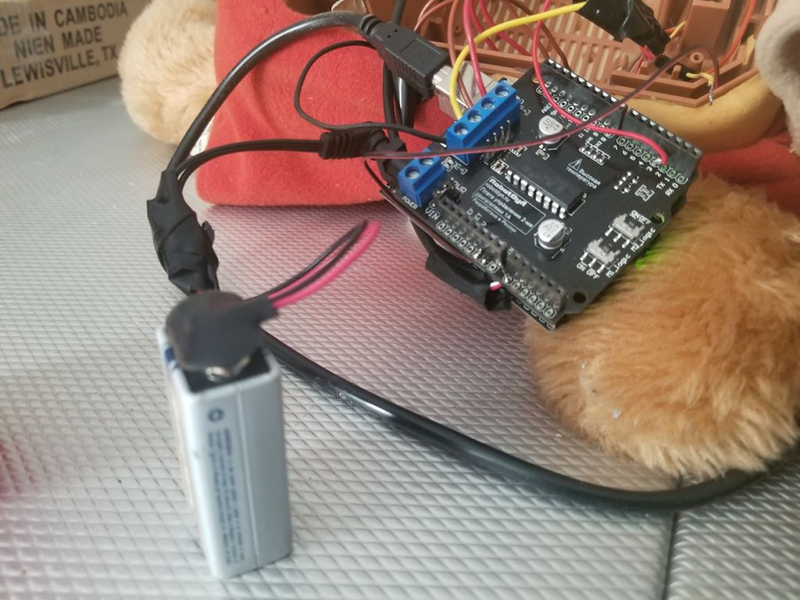In the United States, TV and radio stations have to give the opportunity of equal airtime to all candidates. In that spirit, we thought we should show you [Jayden17’s] hack that puts Google Assistant into a Teddy Ruxpin. You can see the hacked bear do its thing in the video below.
Teddy was the best-selling toy for 1985 and 1986, and is still available, so over 30 years there are a lot of these hanging around. If you never looked at how they work, the original ones were quite simple. A cassette player routed one stereo channel to a speaker and used the other channel to control servo motors to move the mouth and eyes. The cassette was eventually replaced with a digital cartridge, and newer versions of Teddy only use two motors instead of the three in the original.
[Jayden17’s] bear was an original “Worlds of Wonder” bear which means it is from the 1985-1990 time period. If you have a newer bear, you might have to work things out a little differently. These bears often have stuck motors, which can be fixed and broken cassette mechanisms. The cassette isn’t used with this project, so that’s not a problem.
The real key to the project is an Arduino that listens to the audio coming in from a smartphone or other source and drives the motors. The project just uses a cable for the phone, although we would have been tempted to put a cheap Bluetooth receiver in there. However, because of the way it is set up, you could easily do that. You could also use a Raspberry Pi or even switch to Alexa. The Arduino doesn’t know anything about the source audio.
















I don’t understand the reference to electoral candidates at all…?
Well, in the US you have to give equal time on the air to all candidate (it is a little more complicated than that, but for our purposes that’s fine). We’ve talked about putting Alexa in Teddy before. So this time we were talking about putting Google in. Equal time for both candidates, figuratively speaking.
Blimey that’s obtuse – if you’d said something like ‘now google gets an equal hearing’ it would have been clearer.
People forget that the internet has an international audience and just assume everyone knows what we’re talking about.
I used to provide (limited) technical support to international, non-native English speaking customers, and I got in the habit of reviewing my communications with them specifically to make sure a foreign reader would understand what I was about to send.
>
Wait, what about smaller parties and individual candidates?
Could “Joe Shmoe of the Cheeze eating and crackers party” demand as much airtime as the larger parties?
“Equal time for both candidates, figuratively speaking.”
Emphasis on “figuratively speaking”.
There are a lot of qualifiers:
News coverage exempt Documentaries are exempt Etc.
If a tv station, publisher, whatever gives one politician airtime, it must OFFER an equal amount of to to opposing candidates AT THE SAME COST.
If airtime was free, opponents get equal amount of free time, if airtime was purchased, opponent must be able to buy equal amount of similar time for same price.
Politicians pay TOP rates for air time, print ads, etc.
>
Was this done before the release of the Google AIY voice kit for Raspberry Pi? That would seem a perfect fit for this project…
The AIY kit adjust been redone, the earlier version is on deep discount.
https://www.theverge.com/circuitbreaker/2018/4/16/17244802/google-diy-aiy-machine-learning-vision-kit-voice-kit-project-update
The earliest version on deep discount has some serious complaints about nonfunctional hardware/poor support from Google as well. Caveat emptor.
I think the Teddy Ruxpin toy was developed by a battery manufacturer, who wanted to sell a trainload of more batteries.
In practice equal air time is for from what the phrase suggests, IMO it’s statement that shouldn’t be use at all.
Teddy Ruxpin, meet FNAF…
With respect, why is everyone focusing on the opening paragraph of this article and not the actual subject matter at hand here? As for the project itself, it’s not surprising that someone’s done this because I know someone already put Alexa into a Teddy Ruxpin, although, I think that project was fully self contained and didn’t rely on a mobile phone. I can’t remember what hardware they used, probably a Raspberry Pi I’m thinking.
https://hackaday.com/2016/12/24/raspberry-pi-and-alexa-make-teddy-ruxpin-smarter-than-the-average-bear/
This is awesome on so many levels! I have been following your blog for a bit. I have learned so much. I’m now trying to learn to code and hash! Something that is completely foreign to me!